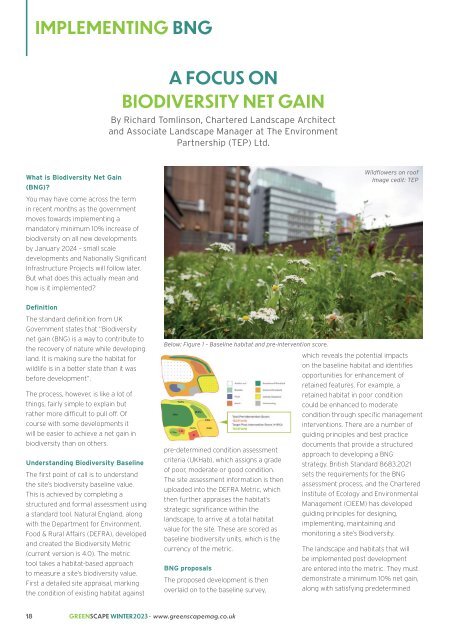Winter 2023
Create successful ePaper yourself
Turn your PDF publications into a flip-book with our unique Google optimized e-Paper software.
IMPLEMENTING BNG<br />
A FOCUS ON<br />
BIODIVERSITY NET GAIN<br />
By Richard Tomlinson, Chartered Landscape Architect<br />
and Associate Landscape Manager at The Environment<br />
Partnership (TEP) Ltd.<br />
What is Biodiversity Net Gain<br />
(BNG)?<br />
You may have come across the term<br />
in recent months as the government<br />
moves towards implementing a<br />
mandatory minimum 10% increase of<br />
biodiversity on all new developments<br />
by January 2024 – small scale<br />
developments and Nationally Significant<br />
Infrastructure Projects will follow later.<br />
But what does this actually mean and<br />
how is it implemented?<br />
Wildflowers on roof<br />
Image cedit: TEP<br />
Definition<br />
The standard definition from UK<br />
Government states that “Biodiversity<br />
net gain (BNG) is a way to contribute to<br />
the recovery of nature while developing<br />
land. It is making sure the habitat for<br />
wildlife is in a better state than it was<br />
before development”.<br />
The process, however, is like a lot of<br />
things, fairly simple to explain but<br />
rather more difficult to pull off. Of<br />
course with some developments it<br />
will be easier to achieve a net gain in<br />
biodiversity than on others.<br />
Understanding Biodiversity Baseline<br />
The first point of call is to understand<br />
the site’s biodiversity baseline value.<br />
This is achieved by completing a<br />
structured and formal assessment using<br />
a standard tool. Natural England, along<br />
with the Department for Environment,<br />
Food & Rural Affairs (DEFRA), developed<br />
and created the Biodiversity Metric<br />
(current version is 4.0). The metric<br />
tool takes a habitat-based approach<br />
to measure a site’s biodiversity value.<br />
First a detailed site appraisal, marking<br />
the condition of existing habitat against<br />
Below: Figure 1 – Baseline habitat and pre-intervention score.<br />
pre-determined condition assessment<br />
criteria (UKHab), which assigns a grade<br />
of poor, moderate or good condition.<br />
The site assessment information is then<br />
uploaded into the DEFRA Metric, which<br />
then further appraises the habitat’s<br />
strategic significance within the<br />
landscape, to arrive at a total habitat<br />
value for the site. These are scored as<br />
baseline biodiversity units, which is the<br />
currency of the metric.<br />
BNG proposals<br />
The proposed development is then<br />
overlaid on to the baseline survey,<br />
which reveals the potential impacts<br />
on the baseline habitat and identifies<br />
opportunities for enhancement of<br />
retained features. For example, a<br />
retained habitat in poor condition<br />
could be enhanced to moderate<br />
condition through specific management<br />
interventions. There are a number of<br />
guiding principles and best practice<br />
documents that provide a structured<br />
approach to developing a BNG<br />
strategy. British Standard 8683.2021<br />
sets the requirements for the BNG<br />
assessment process, and the Chartered<br />
Institute of Ecology and Environmental<br />
Management (CIEEM) has developed<br />
guiding principles for designing,<br />
implementing, maintaining and<br />
monitoring a site’s Biodiversity.<br />
The landscape and habitats that will<br />
be implemented post development<br />
are entered into the metric. They must<br />
demonstrate a minimum 10% net gain,<br />
along with satisfying predetermined<br />
18 GREENSCAPE WINTER<strong>2023</strong> • www.greenscapemag.co.uk

















